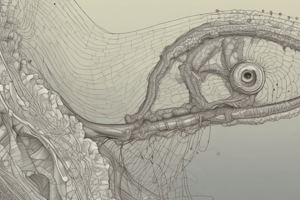Podcast
Questions and Answers
What is the primary characteristic that defines asexual reproduction?
What is the primary characteristic that defines asexual reproduction?
Production of offspring by a single parent
What is the result of binary fission in terms of genetic identity?
What is the result of binary fission in terms of genetic identity?
Daughter cells are genetically identical to the parent cell
What is the significance of the term 'fission' in the context of asexual reproduction?
What is the significance of the term 'fission' in the context of asexual reproduction?
It means to divide
What is the primary difference between asexual reproduction and other modes of reproduction?
What is the primary difference between asexual reproduction and other modes of reproduction?
What is the characteristic that enables organisms to multiply rapidly through asexual reproduction?
What is the characteristic that enables organisms to multiply rapidly through asexual reproduction?
What is the potential exception to the genetic similarity of offspring in asexual reproduction?
What is the potential exception to the genetic similarity of offspring in asexual reproduction?
What is the primary difference between binary fission and budding in terms of the development of a new organism?
What is the primary difference between binary fission and budding in terms of the development of a new organism?
What is the purpose of the sporangium in asexual reproduction?
What is the purpose of the sporangium in asexual reproduction?
Why is simple cell-by-cell division not possible in multicellular organisms?
Why is simple cell-by-cell division not possible in multicellular organisms?
What is the role of regenerative cells in Hydra's reproduction through budding?
What is the role of regenerative cells in Hydra's reproduction through budding?
What is the similarity between yeast and Hydra in terms of their reproductive strategies?
What is the similarity between yeast and Hydra in terms of their reproductive strategies?
What is the adaptive advantage of spore formation in unfavorable environments?
What is the adaptive advantage of spore formation in unfavorable environments?
Study Notes
Asexual Reproduction
- A mode of reproduction where a new offspring is produced by a single parent
- Offspring are genetically and physically identical to each other, i.e., clones of their parents
- Observed in both multicellular and unicellular organisms
- No gamete fusion or change in chromosome number
Characteristics of Asexual Reproduction
- Single parent involved
- No fertilization or gamete formation
- Process occurs in a short time
- Organisms multiply and grow rapidly
- Offspring is genetically similar to the parent
Types of Asexual Reproduction
Binary Fission
- Parent cell divides into two cells, each with a nucleus genetically identical to the parent
- Amoeba and euglena exhibit binary fission
- Process involves replication of DNA, growth of the cell, segregation of DNA, and splitting of cells
- Prokaryotes (e.g., E. coli, Archaea) and eukaryotes (e.g., euglena) reproduce through binary fission
Budding
- New organism develops from a small part of the parent's body
- Bud detaches to develop into a new organism
- Hydra uses regenerative cells for budding
- Bacteria, yeast, corals, flatworms, jellyfish, and sea anemones reproduce through budding
- In yeast, a bud arises as an outgrowth of the parent body, and the nucleus separates into two parts, one shifting into the bud
Spore Formation
- Organism develops sac-like structures called sporangium containing spores during unfavorable conditions
- Spores are released when conditions are favorable and germinate to rise to new organisms
- Fungus like bread mould reproduces asexually by spore formation
- Spores are small spherical bodies with a thick protective coat that protects them from unfavorable conditions
Studying That Suits You
Use AI to generate personalized quizzes and flashcards to suit your learning preferences.
Description
Asexual reproduction is a mode of reproduction in which a new offspring is produced by a single parent. This process does not involve gamete fusion and the new individuals are genetically and physically identical to each other.




